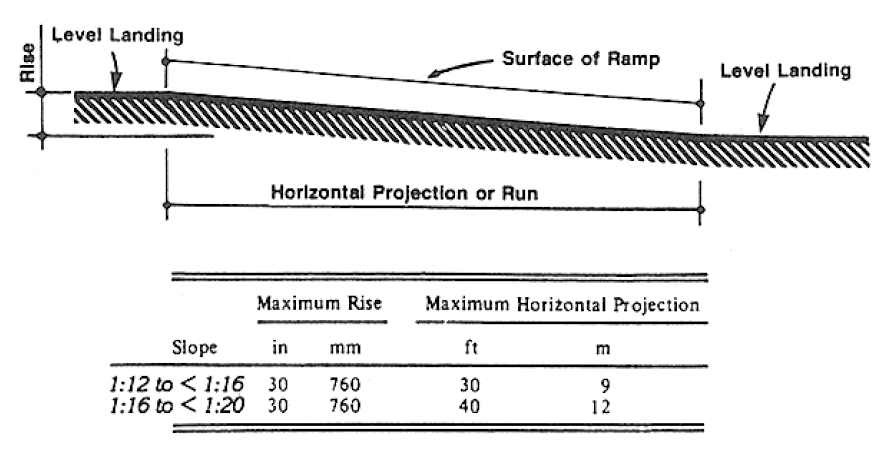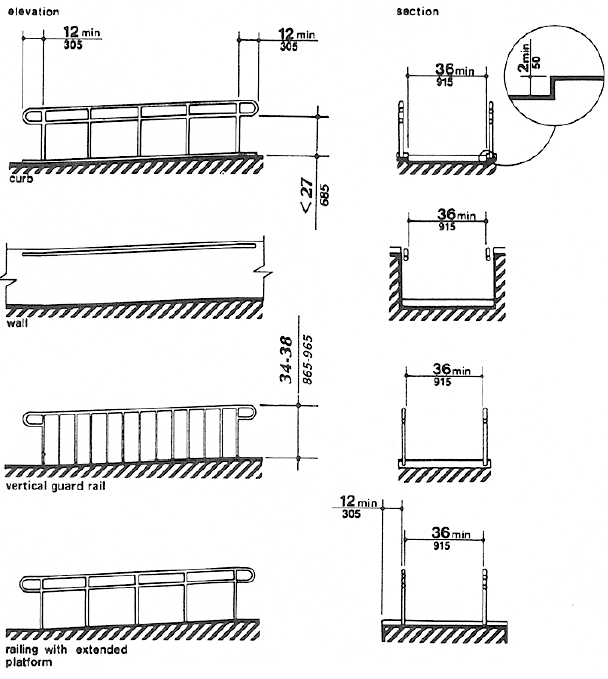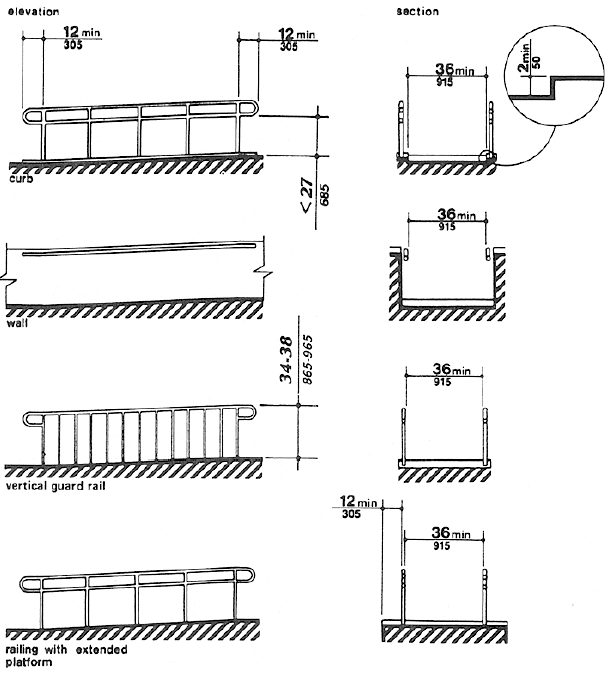4.8 Ramps.
4.8.1* General.
Any part of an accessible route with a slope greater than 1:20 shall be considered a ramp and shall comply with 4.8.
4.8.2* Slope and Rise.
The least possible slope shall be used for any ramp. The maximum slope of a ramp in new construction shall be 1:12. The maximum rise for any run shall be 30 in (760 mm) (see Fig. 16). Curb ramps and ramps to be constructed on existing sites or in existing buildings or facilities may have slopes and rises as allowed in 4.1.6(3)(a) if space limitations prohibit the use of a 1:12 slope or less.
Fig. 16 Components of a Single Ramp Run and Sample Ramp Dimensions
4.8.3 Clear Width.
The minimum clear width of a ramp shall be 36 in (915 mm).
4.8.4* Landings.
Ramps shall have level landings at bottom and top of each ramp and each ramp run. Landings shall have the following features:
(1) The landing shall be at least as wide as the ramp run leading to it.
(2) The landing length shall be a minimum of 60 in (1525 mm) clear.
(3) If ramps change direction at landings, the minimum landing size shall be 60 in by 60 in (1525 mm by 1525 mm).
(4) If a doorway is located at a landing, then the area in front of the doorway shall comply with 4.13.6.
4.8.5* Handrails.
If a ramp run has a rise greater than 6 in (150 mm) or a horizontal projection greater than 72 in (1830 mm), then it shall have handrails on both sides. Handrails are not required on curb ramps or adjacent to seating in assembly areas. Handrails shall comply with 4.26 and shall have the following features:
(1) Handrails shall be provided along both sides of ramp segments. The inside handrail on switchback or dogleg ramps shall always be continuous.
(2) If handrails are not continuous, they shall extend at least 12 in (305 mm) beyond the top and bottom of the ramp segment and shall be parallel with the floor or ground surface (see Fig. 17).
Fig. 17 Examples of Edge Protection and Handrail Extensions
(3) The clear space between the handrail and the wall shall be 1 - 1/2 in (38 mm).
(4) Gripping surfaces shall be continuous.
(5) Top of handrail gripping surfaces shall be mounted between 34 in and 38 in (865 mm and 965 mm) above ramp surfaces.
(6) Ends of handrails shall be either rounded or returned smoothly to floor, wall, or post.
(7) Handrails shall not rotate within their fittings.
4.8.6 Cross Slope and Surfaces.
The cross slope of ramp surfaces shall be no greater than 1:50. Ramp surfaces shall comply with 4.5.
4.8.7 Edge Protection.
Ramps and landings with drop-offs shall have curbs, walls, railings, or projecting surfaces that prevent people from slipping off the ramp. Curbs shall be a minimum of 2 in (50 mm) high (see Fig. 17).
Fig. 17 Examples of Edge Protection and Handrail Extensions
4.8.8 Outdoor Conditions.
Outdoor ramps and their approaches shall be designed so that water will not accumulate on walking surfaces.




User Comments/Questions
Add Comment/Question